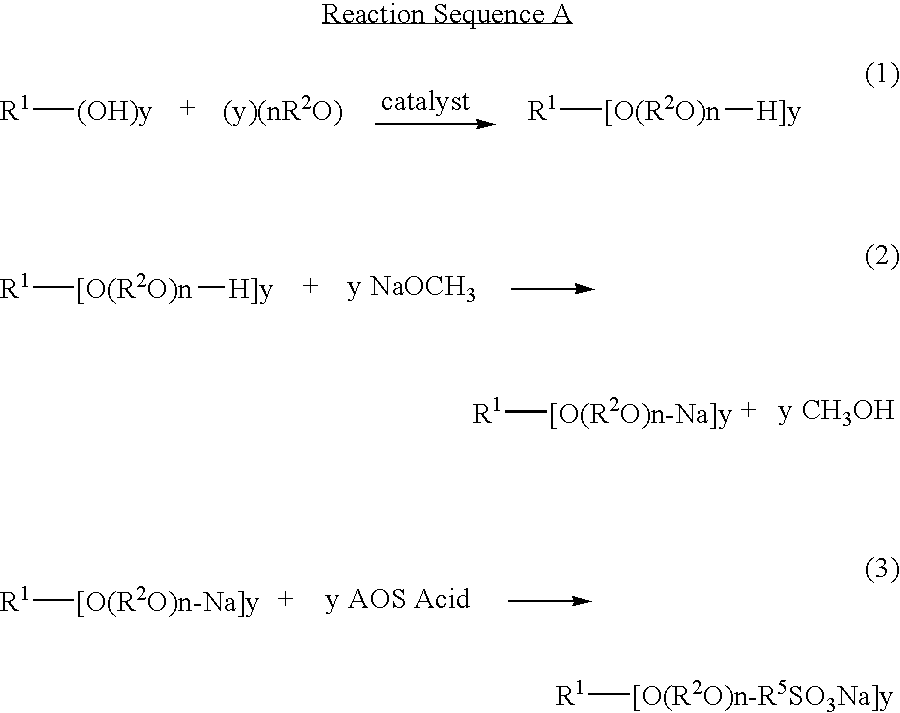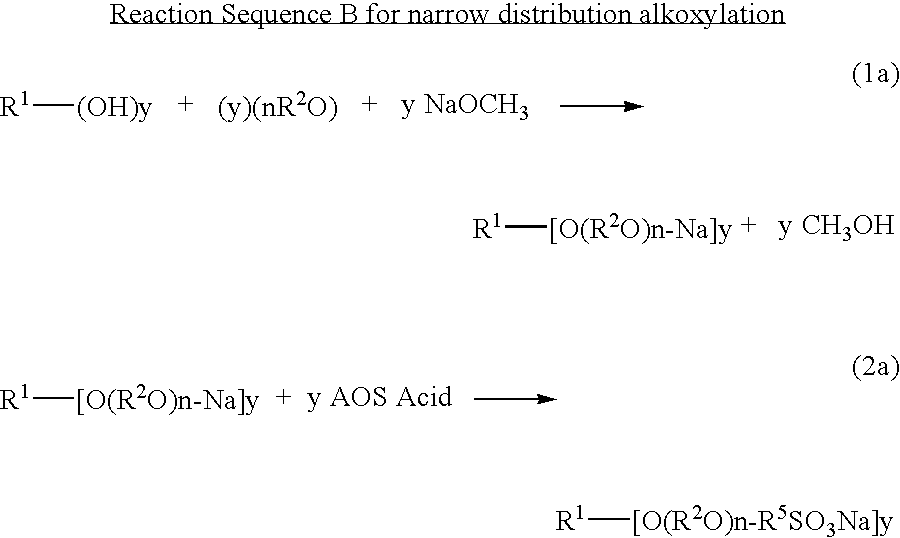Ether sulfonate surfactants and process for making same
a technology of ether sulfonate and surfactants, applied in the field of surfactants, can solve the problems of relative instability, hydrolytic instability of ether sulfates, and limit the conditions and applications where they can be used, and achieve excellent surface tension lowering properties, interfacial tension lowering properties, and easy availability
- Summary
- Abstract
- Description
- Claims
- Application Information
AI Technical Summary
Benefits of technology
Problems solved by technology
Method used
Image
Examples
example 1 preparation
of Alcohol Ether Sulfonates
[0057]This example uses a C10-12 alcohol with 7 moles of Ethylene Oxide and 6 Moles of Propylene Oxide (Witconol™ 1206 from Akzo-Nobel), sodium methylate (Aldrich) and C12 AOS Acid (Bio-terge® AS-12 Acid from Stepan Company) to produce an alcohol ether sulfonate containing both Ethylene and Propylene Oxide groups.
[0058]92.6 (0.100 Mole) grams of C10-12 alcohol with 7 Moles EO and 6 Moles of PO are added to a 250 ml roundbottom flask equipped with a stirrer, temperature controller and reflux condenser. 21.6 (0.100 Mole) grams of sodium methylate (25% in methanol) is added and the mixture is heated to 130° C. while purging with a stream of Nitrogen. After all the methanol has been removed and collected (20.0 grams), 24.8 grams (0.100 Mole) of the C12 AOS Acid is added slowly to maintain the temperature at 130° C. and control the foaming of the reaction. The reaction is completed after 2 additional hours at 130° C. following the addition of the C12 AOS acid.
[...
example 2
Surface Properties of Alcohol Ether Sulfonate from Example 1
[0060]This example demonstrates the excellent surfactant properties of the compositions of the present invention.
[0061]Various surface properties were determined for the product from Example 1 to determine its suitability as a surfactant. All measurements were done at 24° C. unless noted otherwise.
[0062]The Draves wetting time of a 0.1% wt / wt distilled water solution of the product from Example 1 was found to be instantaneous.
[0063]The Surface Tension of a 0.1% w / wt solution of the product from Example 1 was found to be 34.2 mN / m.
[0064]The interfacial tension of a 0.1% in distilled water solution was measured against mineral oil and found to be 0.6 mN / m at 50° C.
[0065]The Critical Micelle Concentration (CMC) of the product from Example 1 was found to be 0.00001 moles / liter.
[0066]The foaming of a 0.5% w / w solution was measured by mixing 100 ml in a Waring Blender at high speed for 30 seconds and immediately pouring the resul...
example 3 preparation
of a Nonylphenol Ethoxysulfonate
[0068]42.8 grams (0.108 Mole) of the 4 Mole ethoxylate of nonylphenol (Witconol™ NP-40 from Akzo-Nobel) were added to a 250 ml round bottom flask equipped with a stirrer, temperature controller and reflux condenser. 17.3 grams (0.108 Mole) of a 25% wt / wt solution of sodium hydroxide in methanol were added and the mixture heated to 130° C. while purging with Nitrogen to remove the methanol. After all the methanol was removed and collected (14.9 grams), 31.4 grams (0.108 Mole) of C14 / 16 AOS Acid (Akzo-Nobel) was added slowly to maintain the temperature and control the foaming. The reaction was continued for an additional 2 hours at 130° C. after completing the addition of the AOS Acid. Before removing the final product from the flask it was allowed to cool to below 90° C. and then diluted with an equal weight (76.7 grams) of water to give a 50% active solution by weight.
[0069]The final product was then analyzed for anionic surfactant, nonionic surfactan...
PUM
| Property | Measurement | Unit |
|---|---|---|
| temperatures | aaaaa | aaaaa |
| temperatures | aaaaa | aaaaa |
| temperatures | aaaaa | aaaaa |
Abstract
Description
Claims
Application Information
 Login to View More
Login to View More - R&D
- Intellectual Property
- Life Sciences
- Materials
- Tech Scout
- Unparalleled Data Quality
- Higher Quality Content
- 60% Fewer Hallucinations
Browse by: Latest US Patents, China's latest patents, Technical Efficacy Thesaurus, Application Domain, Technology Topic, Popular Technical Reports.
© 2025 PatSnap. All rights reserved.Legal|Privacy policy|Modern Slavery Act Transparency Statement|Sitemap|About US| Contact US: help@patsnap.com


